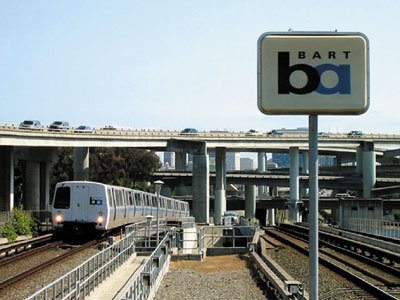A couple of weeks after getting married in June 1964, my parents
were driving through San Francisco on U.S. 101. Just south of Army
Street, a caravan of government cars started passing their
Plymouth.
A couple of weeks after getting married in June 1964, my parents were driving through San Francisco on U.S. 101. Just south of Army Street, a caravan of government cars started passing their Plymouth. My mom looked into the limo in the next lane and was surprised to see sitting inside it President Lyndon Baines Johnson. She waved at the American president and, smiling his famous Texan grin, Johnson waved back.
I’ve often wondered what brought LBJ to the Bay Area that day. Recently I found out. He came to California to preside over the groundbreaking ceremony of the Bay Area Rapid Transit (BART) System. On June 19 of that year, President Johnson oversaw the start of the construction of a 4.4-mile test track between the cities of Concord and Walnut Creek in the East Bay.
BART, of course, did not spring up over night. The massive engineering undertaking began in 1946 when a proposal was made by foresighted Bay Area leaders to develop the heavy rail system as residents grew concerned about the mass migration of people to the region following World War II. To help control congestion on local roads and highways, the burgeoning population needed a fast and efficient modern rapid transit system.
After years of overcoming tremendous engineering, financial and political obstacles, BART officially began operating on Sept. 11, 1972. Today, it’s one of the world’s most highly touted public transportation systems. Several years ago, it received the number one ranking for U.S. transit systems by the American Public Transportation Association.
For 37 years, BART has provided safe and reliable service to Alameda, San Mateo, Contra Costa and San Francisco counties. In the next decade – perhaps as soon as the year 2017 – Santa Clara County might also benefit from BART if a 16.1-mile extension of the rail line is constructed from the Fremont station south to San Jose’s downtown Diridon Station and Santa Clara’s Caltrain Station.
As has always been the case throughout the entire history of BART, this extension isn’t free from political and financial obstacles. The construction will cost a projected $6.1 billion. Part of this cash – a combined total of 24 percent – will come from federal and state government. But before we receive this money, the South Bay must prove it can financially maintain its BART line.
That’s why Santa Clara County residents will see Measure B on their ballots this election cycle. If approved by voters, the proposed one-eighth-cent sales tax collected over 30 years will support the operation and maintenance of the BART extension once it is completed.
Being a fiscal conservative, I’m hesitant about supporting Measure B. Like everyone, I hate to pay more at the store – especially with prices rising as they have been lately. If Measure B goes into effect, it will result in an average Santa Clara County resident paying an additional $13 a year in sales tax – about the cost of three gallons of gasoline at current prices.
Looking at the big picture, however, Measure B dollars might pay for themselves in the long term – especially as pump prices climb steeply. We’d be wise to consider Measure B an investment in improving the quality of life and the quality of the economy in the Bay Area.
The convenience of a BART extension could get as many as 100,000 commuter cars a day off the road, meaning motorists will save money and the environment if they’re not burning fuel into fumes. This will cut down on traffic congestion and air pollution in the South Bay.
Constructing the new rail line will also provide thousands of jobs for local labor. The BART extension to Santa Clara County would generate about 108,000 new jobs within half a mile of all the proposed stations, according to the Metropolitan Transportation Commission.
The BART extension, if it’s ever completed, will create a rail ring around the San Francisco Bay by connecting to Caltrain. Gilroy, San Martin and Morgan Hill would benefit if tourists travel by BART and Caltrain to visit the South Valley. If the tracks leading from Gilroy to Hollister are upgraded to passenger train quality, Caltrain might one day provide service to San Benito County, thus allowing residents there to also enjoy the benefits of BART.
With Measure B, Santa Clara County voters have an important pocketbook decision to make on Election Day. It’s a choice between saving a few dollars or securing our region’s economic fortunes.
On June 19, 1964, President Johnson helped secure the financial future of our region when he officiated over the start of BART. That wise investment paid off handsomely with high economic and quality of life dividends. On Nov. 4, 2008, South Valley voters can increase those dividends and enhance our region’s future by choosing to finally close the Bay Area’s rail ring.












